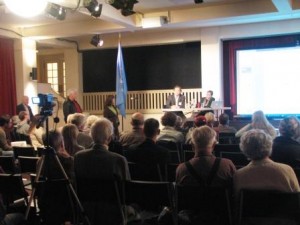Customer Schmustomer: Audience Schmaudience
Chances are your organization has multiple stakeholders. And, chances are many of those stakeholders are sadly neglected. The reasons may vary and at first blush you might react with, “It’s because its too costly or too complex to manage all of those relationships.” But, that usually isn’t the reason for the neglect.
 In reality, most stakeholders receive nary a thought from your organization. You simply have not acknowledged their existence, any more than you’ve inventoried the birds that fly overhead. OK, some smartypants somewhere is saying, “Whoa, wait a minute, our business IS tracking birds.” Yeah, yeah, OK, I hear you.
In reality, most stakeholders receive nary a thought from your organization. You simply have not acknowledged their existence, any more than you’ve inventoried the birds that fly overhead. OK, some smartypants somewhere is saying, “Whoa, wait a minute, our business IS tracking birds.” Yeah, yeah, OK, I hear you.
It isn’t that you’ve intentionally decided to neglect your audience, you didn’t. It’s that you haven’t given them much thought at all. Why would you? After all, you’ve been able to survive this long without paying any attention.
The problem you face, is when others begin to pay more attention to those you’ve neglected. That is often the birth of new organizations whose aim is to supplant yours. And, when that happens, the defection might be tough to prevent or overturn.
So, what’s a good first step? Inventory your stakeholder groups. An easy way to do this is to think of your promise delivery system – the invisible system by which your organization makes and keeps its promises. To whom do you make explicit and implicit promises? And, who is involved in delivering on those promises? Also, who in the extended enterprise helps you? Those are good starters to identify stakeholders beyond the obvious of customers and employees.
 Here are some audience types to spur your thinking, no matter the type or organization you may be involved with: member, customer, donor, investor, visitor, prisoner, voter, citizen, tenant, resident, student, guest, traveler, passenger, performer, elected officials, inspector, owner, parishioner, supplier, vendor, consultant, partner, board member, adviser, council member, leader, refugee, patron, staff, volunteer, client, shareholder, agency, patient, child, doctor, administrator, buyer, licensee, immigrant, refugee, soldier, driver, guide, occupant, person experiencing homelessness, employee, taxpayer.
Here are some audience types to spur your thinking, no matter the type or organization you may be involved with: member, customer, donor, investor, visitor, prisoner, voter, citizen, tenant, resident, student, guest, traveler, passenger, performer, elected officials, inspector, owner, parishioner, supplier, vendor, consultant, partner, board member, adviser, council member, leader, refugee, patron, staff, volunteer, client, shareholder, agency, patient, child, doctor, administrator, buyer, licensee, immigrant, refugee, soldier, driver, guide, occupant, person experiencing homelessness, employee, taxpayer.
 Remember not all audiences are vocal and present. Consider audiences that may not be vocal or present for interviews including people with disabilities, pets and domesticated animals, animals in nature, environmental resources, etc.
Remember not all audiences are vocal and present. Consider audiences that may not be vocal or present for interviews including people with disabilities, pets and domesticated animals, animals in nature, environmental resources, etc.
Audiences are varied and complex. When we provide average experiences for everybody, treating all the same, we miss opportunities to connect with people, make them feel special, respected, wanted, and meaningful. Instead, they can become agitated, irritated, disgruntled and disengaged, perhaps dismissing your organization all together. If you are not intentionally designing experiences for your various audience then they are accidentally evolved at best. Organizations can be at different stages of maturity when it comes to recognizing and serving their various stakeholders. No matter where you are at and no matter your resources, you can employ the same tactics as organizations with the most attentive service cultures.
Here are other tactics once you’ve inventoried the stakeholder groups:
- Inventory your stakeholder groups
- Prioritize audiences by assigning audience “owners”
- Develop personas to make the audience come alive inside the organization
- Explicitly create a promise delivery system for each stakeholder group
- Explore and create customer journey maps for each stakeholder group using the developed personas (and if possible) voice of the customer data
- Create an opportunity map with ideas you can implement to improve outcomes for audiences and for the organization
- Establish operating mechanisms that keep the promise delivery system working smoothly and the audience conversation alive, even as the external environment changes
about the author
Gregory Olson is the author of The Experience Design BLUEPRINT: Recipes for Creating Happier Customers and Healthier Organizations, a book about designing better experiences and then making them come true.
His latest book is L’ impossi preneurs: A Hopeful Journey Through Tomorrow , a light-hearted and deadly serious book about a brighter future where we all live more meaningful lives, governments invest in people and sustainable progress, and technology serves humans.
Chapters in The Experience Design Blueprint that especially pertain to audiences include:
- Chapter 2: Making the Customer Come Alive
- Chapter 3: Who is in the Sandbox?
- Chapter 6: Aiming for Remarkable, Unbroken, and Generous Design
- Chapter 8: Promise Delivery System
- Chapter 9: The Neighborhood
- Chapter 14: The World of Work has Changed
 Gregory Olson founded strategy and design firm Delightability, LLC. with the belief that if you delight customers then success will follow. He believes that we all have the potential to do better, as individuals, organizations, and communities, but sometimes we need a little help. Gregory also serves as a volunteer board member for Oikocredit Northwest, a support association for social investor and financial institution, Oikocredit International.
Gregory Olson founded strategy and design firm Delightability, LLC. with the belief that if you delight customers then success will follow. He believes that we all have the potential to do better, as individuals, organizations, and communities, but sometimes we need a little help. Gregory also serves as a volunteer board member for Oikocredit Northwest, a support association for social investor and financial institution, Oikocredit International.


